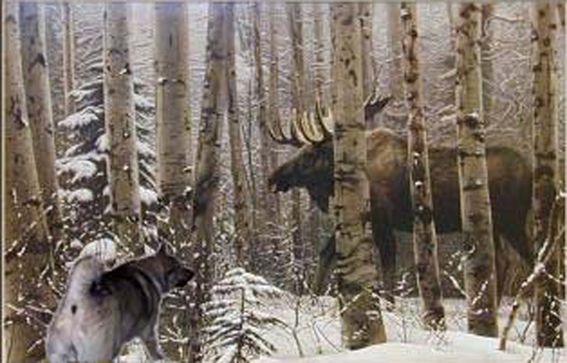![]()
Official Stuff; Breed description and Standard.

Elkhounds are a hunting breed. They were originally bred to hunt Elk ( Moose) in Norway and are used for that to this day. The hunting instinct can be very strong. They do not attack the Elk themselves, but hold it at bay by barking and dancing around it whilst avoiding the vicious hooves. The barking not only annoys the Elk, but also allows the hunter to locate it so that he can stalk and shoot the Elk. The tracking and the hunt may take many hours and cover many miles, so hunter and Elkhound must be fit.
STANDARD OF POINTS
OF THE NORWEGIAN ELKHOUND
(by courtesy of the Kennel Club)
GENERAL APPEARANCE - Powerful; compact body; square outline and proud carriage; coat close and abundant but not open; upstanding pointed ears; tail tightly curled over back.
CHARACTERISTICS - A hardy hunting Spitz with a bold energetic disposition.
TEMPERAMENT - Friendly, intelligent and independent without any sign of nervousness.
HEAD AND SKULL - Wedge shaped, comparatively broad between ears; stop, not large; forehead and back of head slightly arched; foreface broad at root (not pinched in), evenly tapering whether seen from above or side, never pointed; bridge of nose straight and approximately the length of the forehead; tight fitting skin on head, no wrinkle.
EYES - Not prominent, slightly oval, medium size, dark brown, giving frank fearless and friendly expression.
EARS - Set high, small, firm and erect, pointed and very mobile; slightly taller than width at base; when alert, outer edge should be vertical.
MOUTH - Jaws strong with perfect, regular scissor bite, i.e. the upper teeth closely overlapping the lower teeth and set square to jaws.
NECK - Medium length, powerful, carrying the head high; a rich ruff on close fitting skin but no dewlap.
FOREQUARTERS - Legs straight with good, not coarse, bone and strong pasterns; shoulders sloping; elbows set in.
BODY - Powerful; short, strong back; loin short and wide with very little tuck-up; chest deep and broad; well curved ribs; top line straight and level; distance from brisket to ground not less than half the height at the withers.
HINDQUARTERS - Legs firm, strong and powerful; little but definite bend at stifle and hock; straight when viewed from behind.
FEET - Comparatively small, slightly oval, tightly closed, well arched toes with protective hair between thick pads; turning neither in nor out. Nails firm and strong.
TAIL - Strong, set on high; thickly coated without plume; tightly curled, preferably over the centre line of the back.
GAIT/MOVEMENT - Demonstrates agility and endurance; stride at the trot even and effortless, back remaining level; as speed of trot increases, front and rear legs converge equally in straight lines towards a centre line beneath the body.
COAT - Close, abundant, weather resistant; soft, dense, woolly undercoat and coarse, straight outer coat; short and smooth on head and front of legs, slightly longer on back of front legs, longest on neck, back of thighs and tail; not trimmed.
COLOUR - Grey of various shades, with black tips to outer coat; lighter on chest, stomach, legs, underside of tail, buttocks and in a harness mark; ears and foreface dark; a dark line from eye to ear desirable; undercoat pure pale grey. Any pronounced variation from the grey colour, sooty colour on lower legs, spectacles or white markings undesirable.
SIZE - Ideal height at shoulder, Dogs 52 cm (20.5 inches); Bitches 49 cm (19.5 inches). Weight approximately 23 Kg (50 lbs) and 20 Kg (43 lbs) respectively.
FAULTS - Any departure from the foregoing points should be considered a fault and the seriousness with which the fault should be regarded should be in exact proportion to its degree and its effect upon the health and welfare of the dog.
NOTE - Male animals should have two apparently normal testicles fully descended into the scrotum.